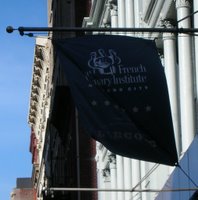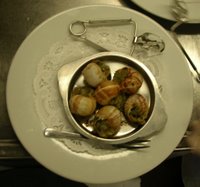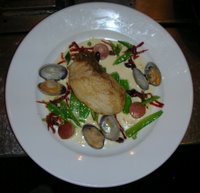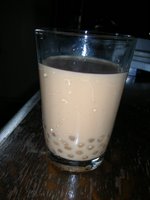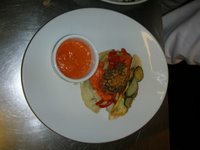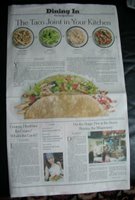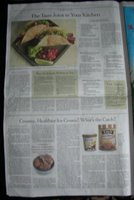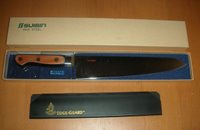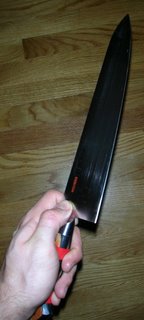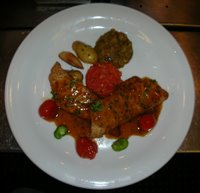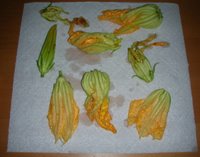
My father is from Westfield, Massachusetts and my grandparents still live on land my great-grandfather, Sabatino Bovino, bought when he came from Italy. Sabatino was from
Caserta, Southern Italy. The house, built by Arthur Bovino Sr., my grandfather, is on a hill on East Mountain Road. The hillside was terraced for grapes and gardens by my great-grandfather. My grandparents still grow corn, vegetables, and grapes.

From the ages of 8 to 13 if it was summertime my sister and I stayed with my grandparents while my father worked in Hong Kong and my mother went to school for her doctorate at Columbia University in New York.
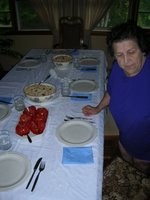
During those summer months we played games in the large field behind the house, ate fresh corn on the cob, salads filled with garden tomatoes, cucumbers and lettuces on plates then straight out of the bowl, sugar cereals we weren't allowed at home and night after night quietly ate my grandmother's (Grandma Helen, right) cooking, spoiled by blueberry and apple pies, cream puffs and chocolate devil dogs.
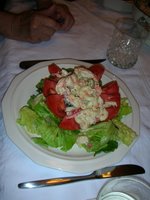
When we visit now, as we did yesterday, we still come away with the spoils of my grandparents garden-tending and cooking. Above left, we sat by the picture window before dinner talking and snacking before sitting down at the table, right, to eat a seafood pasta over sliced tomato and dressed salad. After dinner we went for a walk in the garden and in the back field...
 On the terraced levels next to the road on the way up to the house my grandfather has planted corn, squash, zucchini, and cucumber. Usually they grow eggplant too. But the cucumber plants have been nibbled away at this summer.
On the terraced levels next to the road on the way up to the house my grandfather has planted corn, squash, zucchini, and cucumber. Usually they grow eggplant too. But the cucumber plants have been nibbled away at this summer.
 My grandfather says that a buck has been coming up the road from the fields across the street and snacking on the cucumber plants. Many animals visit the gardens, from bears and rabbits to racoons and deer.
My grandfather says that a buck has been coming up the road from the fields across the street and snacking on the cucumber plants. Many animals visit the gardens, from bears and rabbits to racoons and deer.
 Bears, rabbits and deer are left alone-- racoons are dealt with. My grandfather used to trap and drive them to the quarry across the street to let them go but he said they kept returning so he had to start doing something more final with them.
Bears, rabbits and deer are left alone-- racoons are dealt with. My grandfather used to trap and drive them to the quarry across the street to let them go but he said they kept returning so he had to start doing something more final with them.
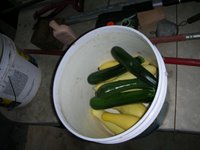 But the zucchini and the squash haven't been eaten by the local deer; vegetables awaited us in buckets on the porch. I'll do squash and eggs when we get back to New York; butter, pepper and salt and you've got a light, buttery lunch or dinner.
But the zucchini and the squash haven't been eaten by the local deer; vegetables awaited us in buckets on the porch. I'll do squash and eggs when we get back to New York; butter, pepper and salt and you've got a light, buttery lunch or dinner.
 At the bottom of the plants were some zucchini blossoms ready to be picked. My sister said that in Italy, her boyfriend dips the blossoms in a light batter and then fries them. Interested in trying to do this myself, I picked some of the blossoms, trying to take mostly those which were on zucchini which were already growing otherwise there won't be any vegetables.
At the bottom of the plants were some zucchini blossoms ready to be picked. My sister said that in Italy, her boyfriend dips the blossoms in a light batter and then fries them. Interested in trying to do this myself, I picked some of the blossoms, trying to take mostly those which were on zucchini which were already growing otherwise there won't be any vegetables.
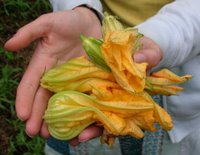 I carefully wrapped them in paper towels and put them in a plastic bag to bring home. We were able to get some pretty blossoms. I've never had them before and I'm not sure what they could be served with. I'll have a better idea tomorrow.
I carefully wrapped them in paper towels and put them in a plastic bag to bring home. We were able to get some pretty blossoms. I've never had them before and I'm not sure what they could be served with. I'll have a better idea tomorrow.
 My great-grandfather didn't bring the Concord grapes from Italy, but he planted them more than a hundred years ago once he terraced the hillside. There are three rows of grape vines growing with the support of small metal posts and wire.
My great-grandfather didn't bring the Concord grapes from Italy, but he planted them more than a hundred years ago once he terraced the hillside. There are three rows of grape vines growing with the support of small metal posts and wire.
 Tended after by my great-grandmother, Rosa Grimaldi and then my grandfather, above, the vines still produce. My grandparents harvest the grapes and make their own wine in the basement in large wood barrels. There are shelves of wines on the wall from the past two or three years, the grape silt settling at the bottom of large, old, wine jugs.
Tended after by my great-grandmother, Rosa Grimaldi and then my grandfather, above, the vines still produce. My grandparents harvest the grapes and make their own wine in the basement in large wood barrels. There are shelves of wines on the wall from the past two or three years, the grape silt settling at the bottom of large, old, wine jugs.
 On one of the terrace-levels is a pear tree planted by my great-grandmother (originally from Ciorani, Salerno). It still bears fruit, more in fact than my grandfather can eat. A few years ago he had to cut off some of the larger branches because the tree was getting unmanageable, to the point of putting it in danger. But as you can see (at right) the tree is still very bountiful.
On one of the terrace-levels is a pear tree planted by my great-grandmother (originally from Ciorani, Salerno). It still bears fruit, more in fact than my grandfather can eat. A few years ago he had to cut off some of the larger branches because the tree was getting unmanageable, to the point of putting it in danger. But as you can see (at right) the tree is still very bountiful.
 My grandmother bottles the pears in jars in a simple syrup. As you can see there are plenty of pears weighing down the boughs of the tree right now but they're hard as rocks and won't be ripe until the middle to or the end of August.
My grandmother bottles the pears in jars in a simple syrup. As you can see there are plenty of pears weighing down the boughs of the tree right now but they're hard as rocks and won't be ripe until the middle to or the end of August.
 Up the road is the house to the left. I carelessly banged my head a couple more times than I'd care to admit on the pointed right eave of the roof while playing basketball with a hoop that used to be in the driveway. Blame that for my crazy ideas.
Up the road is the house to the left. I carelessly banged my head a couple more times than I'd care to admit on the pointed right eave of the roof while playing basketball with a hoop that used to be in the driveway. Blame that for my crazy ideas.
 Up the slightly gravelled road is the swimming pool and the greenhouse, the shed for the tractor, and the place where my grandfather used to burn garbage in a large metal can. During the winter this was the safe hill I learned to ride a sled on when it was covered with snow. When we got older and more daring we'd slide down the front road and the back field on smooth, concave garbage can lids. Now that was fun.
Up the slightly gravelled road is the swimming pool and the greenhouse, the shed for the tractor, and the place where my grandfather used to burn garbage in a large metal can. During the winter this was the safe hill I learned to ride a sled on when it was covered with snow. When we got older and more daring we'd slide down the front road and the back field on smooth, concave garbage can lids. Now that was fun.
 We'd cool off in the pool after playing hide and seek, riding bikes, and marveling at the wrecks of old cars from the 1930's and 40's sunken into the forest behind it-- springs and rusted gears, worn-away dashboards, and faded colors.
We'd cool off in the pool after playing hide and seek, riding bikes, and marveling at the wrecks of old cars from the 1930's and 40's sunken into the forest behind it-- springs and rusted gears, worn-away dashboards, and faded colors.
 Beyond the pool at the top of the ridge is a large field which used to be filled with corn. My grandparents planted different fruit trees there: plum trees, apple trees, cherry trees, and peach trees. To the right of the trees is an old shed built for the horse my uncle brought home many years ago. The horse made it a habit of jumping over the fence and running down the street to the neigbhors' houses.
Beyond the pool at the top of the ridge is a large field which used to be filled with corn. My grandparents planted different fruit trees there: plum trees, apple trees, cherry trees, and peach trees. To the right of the trees is an old shed built for the horse my uncle brought home many years ago. The horse made it a habit of jumping over the fence and running down the street to the neigbhors' houses.
 After the horse died my grandparents used the shed to house steer. I remember 'Din-Din,' the most. As a kid I helped my grandfather toss corn stalks over the fence for him to eat. Not long after WE were eating 'Din-Din.'
After the horse died my grandparents used the shed to house steer. I remember 'Din-Din,' the most. As a kid I helped my grandfather toss corn stalks over the fence for him to eat. Not long after WE were eating 'Din-Din.'
 This year there's not much fruit. There has been a lot of rain in Westfield and while the flowers on the trees bloomed, the rain kept the bees from pollinating. There were a few lonely apples on the branches. No homemade applesauce this year.
This year there's not much fruit. There has been a lot of rain in Westfield and while the flowers on the trees bloomed, the rain kept the bees from pollinating. There were a few lonely apples on the branches. No homemade applesauce this year.
 The same thing happened with the other fruit trees. There wasn't a plum or cherry to be seen (it's usually a battle with the birds to get any of that fruit anyway) and there were only a few peaches-- nothing much to speak of. Even more sad than no applesauce is no homemade pies made with garden fruit. Hopefully next year will be a little more promising.
The same thing happened with the other fruit trees. There wasn't a plum or cherry to be seen (it's usually a battle with the birds to get any of that fruit anyway) and there were only a few peaches-- nothing much to speak of. Even more sad than no applesauce is no homemade pies made with garden fruit. Hopefully next year will be a little more promising.
 Down the field on the other side is a smaller garden and along it a row of rasberry bushes. My uncle also has a house on the top of the ridge where he lives with his wife who happened on a bear sitting in the bush one day.
Down the field on the other side is a smaller garden and along it a row of rasberry bushes. My uncle also has a house on the top of the ridge where he lives with his wife who happened on a bear sitting in the bush one day.
 Last year I arrived too late for the berries. They'd been picked away at by the birds and the rest of them were dried up by a few late hot summer days in a row. It's a sad summer when you miss a chance to pick your own berries.
Last year I arrived too late for the berries. They'd been picked away at by the birds and the rest of them were dried up by a few late hot summer days in a row. It's a sad summer when you miss a chance to pick your own berries.
 Today I went berry-picking determined to come away with something to show for it and I wasn't disappointed. I easily found a handful of bright red berries which I was more than willing to share with anyone who wanted some.
Today I went berry-picking determined to come away with something to show for it and I wasn't disappointed. I easily found a handful of bright red berries which I was more than willing to share with anyone who wanted some.
 I munched on them on the way down to the bottom of the field. Slightly warm and a little wet from the rain storm which had just passed through, the berries were still a little firm, sweet and tasty. A very nice after-dinner treat.
I munched on them on the way down to the bottom of the field. Slightly warm and a little wet from the rain storm which had just passed through, the berries were still a little firm, sweet and tasty. A very nice after-dinner treat.
 At the very bottom of the hill is a mulberry tree I don't remember terribly well being there as a kid. It's the tree casting the shadow at the bottom of the field before the wall of trees. The land is surrounded by trees on three sides. They used to go a lot farther back and it was a thick forest in which as a kid you could almost get lost climbing over fallen trees, finding huge forest mushrooms we'd been told in no uncertain terms not to eat.
At the very bottom of the hill is a mulberry tree I don't remember terribly well being there as a kid. It's the tree casting the shadow at the bottom of the field before the wall of trees. The land is surrounded by trees on three sides. They used to go a lot farther back and it was a thick forest in which as a kid you could almost get lost climbing over fallen trees, finding huge forest mushrooms we'd been told in no uncertain terms not to eat.
 We used to go for walks in the forest with my grandfather, walking stick in hand looking for tiny red teaberries. Most of the land belonged to other people who have since sold off their parts to a school and housing development. We'd missed the berries by a week or two. There were only a few unripe berries left.
We used to go for walks in the forest with my grandfather, walking stick in hand looking for tiny red teaberries. Most of the land belonged to other people who have since sold off their parts to a school and housing development. We'd missed the berries by a week or two. There were only a few unripe berries left.
 Close to the wall of trees on the left is a hole where my grandparents have been throwing food scraps for decades for the animals. You take away from the land and you give back to the wildlife.
Close to the wall of trees on the left is a hole where my grandparents have been throwing food scraps for decades for the animals. You take away from the land and you give back to the wildlife.
 Behind the scrap-pit is a blackberry bush. It's still a little early in the year for the bush to be bearing any fruit. The only thing missing here berry-wise as far as I'm concerned are strawberries. Yup, I'm spoiled.
Behind the scrap-pit is a blackberry bush. It's still a little early in the year for the bush to be bearing any fruit. The only thing missing here berry-wise as far as I'm concerned are strawberries. Yup, I'm spoiled.
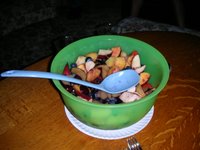 When we got back to the house there was some fruit salad waiting for us. I ate the fruit while looking out the picture window at the field across the way. There used to be what I always thought of as a small rock mountain behind the field where my uncle took the snowmobile during the winter. But over the years the quarry has been at work until now, there's not even so much as a hill left to speak of.
When we got back to the house there was some fruit salad waiting for us. I ate the fruit while looking out the picture window at the field across the way. There used to be what I always thought of as a small rock mountain behind the field where my uncle took the snowmobile during the winter. But over the years the quarry has been at work until now, there's not even so much as a hill left to speak of.
 In the basement on shelves below the stairs are lots of bottles and canning jars for fruit that my grandmother puts up. She also puts up eggplant and mushrooms in oil with herbs, hot pepper and garlic. They're really good on bread during colder months.
In the basement on shelves below the stairs are lots of bottles and canning jars for fruit that my grandmother puts up. She also puts up eggplant and mushrooms in oil with herbs, hot pepper and garlic. They're really good on bread during colder months.
 At the other end of the basement is the wine-making area. Grandma Helen tells me that on September the 26th to be exact, the Concord grapes are usualy ripe enough for them to pick.
At the other end of the basement is the wine-making area. Grandma Helen tells me that on September the 26th to be exact, the Concord grapes are usualy ripe enough for them to pick.
 Within a day or two they decide what and how much they have to work with. Then they crush the grapes in the crusher (at right, the tool at the back left against the wall) which breaks the skins to excrude the juices. They also have a screen under the crusher to catch as much of the stems as possible. This is all done in a large open barrel for fermenting.
Within a day or two they decide what and how much they have to work with. Then they crush the grapes in the crusher (at right, the tool at the back left against the wall) which breaks the skins to excrude the juices. They also have a screen under the crusher to catch as much of the stems as possible. This is all done in a large open barrel for fermenting.
 Then they add their yeast and sugar to start the fermentation. They cover the barrel with clean, clear plastic for 6-7 days, depending on the color they want. My grandfather pushes the must down and stirs it up twice a day during fermentation. They drain the juices from the bottom spicket into a half barrel so they can transfer it to smaller, closed barrels. There the juice continues to ferment, and sugar is added to keep the process working and forming alcohol for 6 months or more.
Then they add their yeast and sugar to start the fermentation. They cover the barrel with clean, clear plastic for 6-7 days, depending on the color they want. My grandfather pushes the must down and stirs it up twice a day during fermentation. They drain the juices from the bottom spicket into a half barrel so they can transfer it to smaller, closed barrels. There the juice continues to ferment, and sugar is added to keep the process working and forming alcohol for 6 months or more.
 A plastic bubbler lets air out but doesn't allow it in to the closed barrel. They test for color, flavor and alcohol levels. Then, when they're satisfied, they bottle it in gallons for their own use. By law, you are allowed to make 25 gallons per family.
A plastic bubbler lets air out but doesn't allow it in to the closed barrel. They test for color, flavor and alcohol levels. Then, when they're satisfied, they bottle it in gallons for their own use. By law, you are allowed to make 25 gallons per family.
 The whole process takes from September 26th to about April. The bottle on the left is the 2005 wine I brought home with me from this trip (we've had a few glasses as you can see). On the right is a bottle of last year's wine, complete with the family label, a picure of my great-grandfather.
The whole process takes from September 26th to about April. The bottle on the left is the 2005 wine I brought home with me from this trip (we've had a few glasses as you can see). On the right is a bottle of last year's wine, complete with the family label, a picure of my great-grandfather.
 The label reads: Bovino's Fine Italian Concorde Table Wine
The label reads: Bovino's Fine Italian Concorde Table Wine
It's pretty strong stuff. As my grandfather warns with a smile, "Be careful, if you drink too much you'll become ubbriaco," which I understand to mean a drunk.
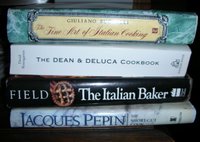 I came away with a few more gifts. My grandmother gave me some cookbooks she thought I might enjoy using. I'll be adding them to my library (which I plan to feature soon in one of the daily Kitchen Toro features). Grandma gave me four books:
I came away with a few more gifts. My grandmother gave me some cookbooks she thought I might enjoy using. I'll be adding them to my library (which I plan to feature soon in one of the daily Kitchen Toro features). Grandma gave me four books:
The Art of Italian Cooking by Giuliano Bugialli
The Dean & Deluca Cookbook by David Rosengarten with Joel Dean and Giorgio DeLuca
The Italian Baker by Carol Field
The Short-Cut Cook by Jacques Pepin
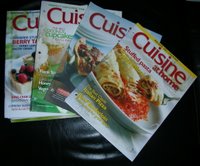 She also gave me some old Cuisine magazines. They're full of recipes, not advertisements. While they seem to be more like home recipes, hey you never know, home-cooking can be found in a lot of haute cuisine places around the city!
She also gave me some old Cuisine magazines. They're full of recipes, not advertisements. While they seem to be more like home recipes, hey you never know, home-cooking can be found in a lot of haute cuisine places around the city!

FULL POST...
 For all you Kitchen Toro visitors out there, everything's on delay as I've only just gotten back to New York from a food road-trip this weekend. All KT features will be updated tonight, and hopefully not long after I'll have a special post for you, Back in Black.
For all you Kitchen Toro visitors out there, everything's on delay as I've only just gotten back to New York from a food road-trip this weekend. All KT features will be updated tonight, and hopefully not long after I'll have a special post for you, Back in Black. Today's site is one I've mentioned before on Kitchen Toro, davidlebovitz.com. No harm mentioning it again because it's one that I'll look at from time to time to see what he's doing with desserts. I've been meaning to pick up his book, "The Great Book of Chocolate," but you can also check out things he's making on his recipes page.
Today's site is one I've mentioned before on Kitchen Toro, davidlebovitz.com. No harm mentioning it again because it's one that I'll look at from time to time to see what he's doing with desserts. I've been meaning to pick up his book, "The Great Book of Chocolate," but you can also check out things he's making on his recipes page.
